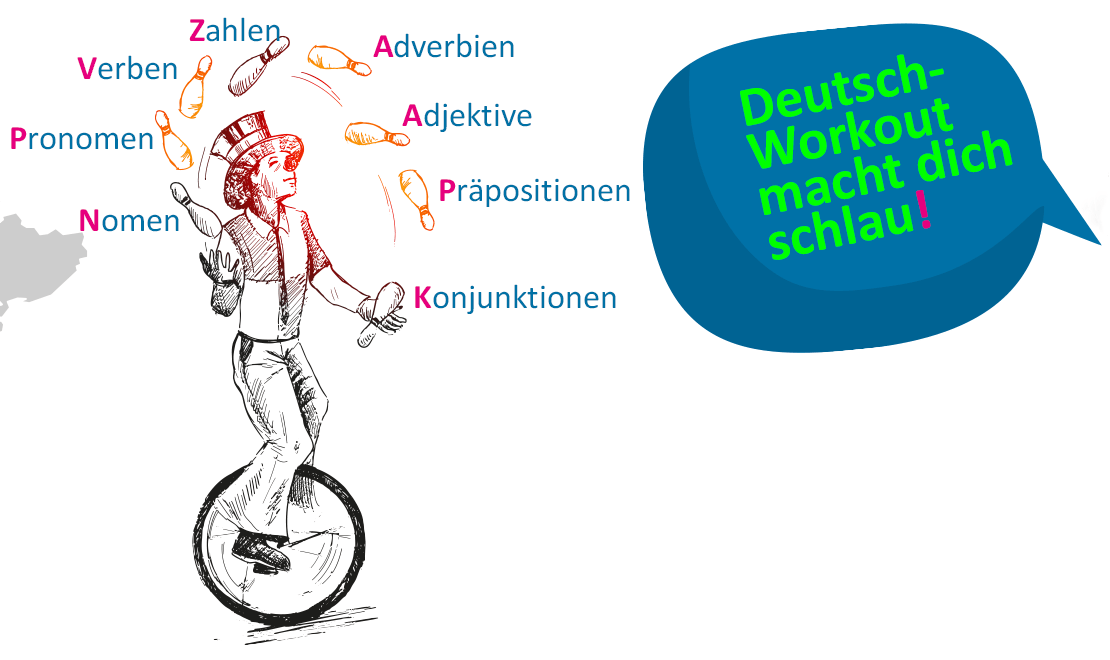Adjectives and adverbs express qualities, characters of a person, action, undertaking, atmosphere or phenomena etc.. They therefore come before nouns and complement the meaning of the nouns. At A1 level, they are rarely used for this function. Their function is limited to complementing the verbs “sein” and “werden” and in the use of comparatives, comparatives and superlatives. Depending on their position in the sentence, the same words adverbs or adjectives apply. The typical W-question for an answer with an adjective is “wie”.
Contents

1. adjectives, adjective formation in the comparative and superlative case
| Grundform der Adjektive | Komparativ > Adjektive + er | Superlativ > Adjektive + st- | Superlativ von Adjektiven zu Adverb > am Adjektiv + sten |
|---|---|---|---|
| alt <> modern | älter <> moderner | ältest- <> modernst- | am ältesten <> modernsten |
| breit <> schmal | breiter <> schmaler | breitest- <> schmalst- | am breitesten <> schmalsten |
| hoch <> niedrig | höher <> niedriger | höchst- <> niedrigst- | am höchsten <> niedrigsten |
| klein <> groß | kleiner <> größer | kleinst- <> größt- | am kleinsten <> größten |
| leicht <> schwer | leichter <> schwerer | leichtest- <> schwerst- | am leichtesten <> am schwersten |
| schön <> hässlich | schöner <> hässlicher | schönst- <> hässlichst- | am schönsten <> hässlichsten |
| teuer <> billig | teurer <> billiger | teuerst- billigst- | am teuersten <> billigsten |
| viel <> wenig | mehr <> weniger | meist- <> wenigst- | am meisten <> wenigsten |
Examples:
| Wie ist das Projekt? | Es ist super schwer, aber sehr spannend. |
| Wie sind die Speisen? | Sie sind sehr lecker, köstlich, aber relativ teuer. |
| Wie werden die Früchte nach 2 Tagen? | Nach 2 Tagen werden sie verfault und vergammelt. |
| Welche Aufgaben sind für dich leichter oder schwerer? | Sprechen ist für mich leichter als Schreiben. Schreiben ist für mich schwerer als Sprechen. |
| Welche Süßigkeit isst du täglich am meisten? | Ich esse jeden Tag am meisten Kuchen. |
| Wo steht die höchste Kirche in Deutschland? | Sie steht in Köln und das ist der Kölner Dom. |
Attention:
1. Vowel change from a,o,u to ä,ö,ü occurs in monosyllabic adjectives with vowels a,o,u in the comparative and superlative, e.g. alt, hoch, groß to älter-amältesten,höher-amhöchsten,größer-amgrößten.
2. “s” is dropped at the end of adjectives with ß ,z,s. Example: big> größer-am größten. “e” is added in the superlative to adjectives with t,d, for example: leicht> amleichtesten, alt- amältesten
3. Adjectives in the superlative to complement nouns are provided with definite articles, e.g. die höchste church.
2. adverbs in German
Adverbs complement the meaning of adjectives and nouns when they come before them. If they complement the action in the sentence, i.e. the verb, they are placed at the end of the sentence.

Most adjectives are also adverbs. In this case, they differ only in their role in the sentence. Adverbs are never declined and remain unchanged, whereas adjectives are always declined before nouns. The typical W question for an answer with adverbs is also wie and wie + adverbs.
Positions of adverbs in the sentence
| W-Fragen | Aussagen/ Antworten |
|---|---|
| Wie oft lernst du Deutsch? | Zweimal für etwa eineinhalb Stunden lerne ich täglich Deutsch. |
| Wie breit ist dein Schreibtisch? | Er ist 160cm breit. |
| Wie findest du die Hauptstadt der Deutschen? | Ich finde sie ambivalent, sehr schön, aber auch sehr hässlich. |
| Ja-/Nein-Fragen | Antworten auf Ja-/Nein-Fragen |
|---|---|
| Gehst du nicht zur Arbeit? | Doch. Aber nicht heute gehe ich zur Arbeit, sondern morgen. |
| Gehst du am liebsten ins Museum im Urlaub? | Nein. Ich gehe am liebsten zum Strand im Urlaub. |
| Besuchst du selten einen Park? | Ja. Ich besuche selten einen Park. Denn ich wohne schon im Wald. |
Adverbs at A1 level can be summarized with the following characteristics: temporal adverbs: “heute, morgen, täglich, jährlich, zuerst, dann, danach” etc. modal adverbs: oft, “selten, nie, immer, langweilig, cool, interessant, allein, zusammen” etc. local adverbs: hier, dort, drüben, da, drinnen, draußen etc. In short, we say TE-MO-LO. Because in the sentence they are also in the following order: first temporal, then modal and finally local adverb.
Attention:
1. The typical W questions for answers with an adverb represent a simplified, level-appropriate understanding of the use of adverbs in a sentence.
2. For orientation, the rule Te-Mo-Lo applies in the sentence. Temporal and local adverbs are independent and complement verbs. It is different with modal adverbs, as they can and may generally complement subject, verb or temporal adverbs or local adverbs. Their position is therefore flexible.
3. „Nicht, nie, kaum“ are modal adverbs for negation. They therefore enjoy using modal adverbs.
Example:
Wann, mit wem und wo lernst du häufig Deutsch? – Ich lerne immer von 14 bis 17 Uhr mit einer Schulfreundin Deutsch in der Stadtbibliothek.



